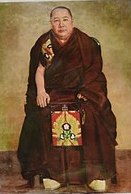Lobsang Pelden Tenpe Dronme | |
|---|---|
 | |
| Personal life | |
| Born | 1890 Datong, Qinghai, China |
| Died | 4 March 1957 (aged 66–67) Taipei, Taiwan |
| Religious life | |
| Religion | Tibetan Buddhism |
| School | Gelug |
| Lineage | Changkya Khutukhtu |
| Senior posting | |
| Predecessor | Changkya Lozang Tendzin Gyeltsen |
| Successor | Changkya Tendzin Dönyö Yéshé Gyatso |
| Reincarnation | Changkya Dragpa Öser |
Lobsang Pelden Tenpe Dronme (Tibetan : ལྕང་སྐྱ་བློ་བཟང་དཔལ་ལྡན་བསྟན་པའི་སྒྲོན་མེ་, Wylie : lcang skya blo bzang dpal ldan bstan pa'i sgron me, Chinese :羅桑般殿丹畢蓉梅; pinyin :Luósāng Bāndiàn Dānbì Róngméi; 1890 – 4 March 1957) was a Tibetan Buddhist tulku and lama who was the 7th Changkya Khutukhtu. He was the highest person of Tibetan Buddhism in Inner Mongolia [ citation needed ] and the fourth highest lamas of Tibetan Buddhism[ citation needed ] in general. He supported the Kuomintang and accompanied the Republic of China government to Taiwan after the Chinese Civil War in 1949. [1] He was awarded titles by the Kuomintang and also received living expenses until his death. [2] It is believed that before his death in 1957 he had signed a pledge that he would not reincarnate until the Republic of China retook the mainland. [3]
Contents
After his death, his residence in Taipei was converted in February 1993 into the Mongolian and Tibetan Cultural Center, which includes a memorial to him.
